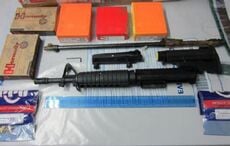It was morning in Pamplona, a town in north-eastern Spain. The sun had just risen and the wind blew gently through the streets. Three friends had come for the encierro.
I had decided to run with the bulls too.
‘Encierro’ translates to the ‘lock-up’ in English. But in this part of Spain it means ‘to run with bulls’.
Bulls are released from a corral (livestock pen) about 800 meters outside the bullring and gallop their way through the streets until they get to the ring so that they can take part in the evening’s corrida (bullfight). It’s the traditional way of getting the bulls to the ring. It has also become tradition that men and women run with them.
Last Sunday morning just after 7am I stood about 150 meters from the corral with an empty leather wine bota (it had been full of red wine at 2am) wrapped around my shoulder, a red panuelo scarf around my neck and a white shirt – traditional San Fermin attire – to take part in this tradition.
Men were erecting wooden fences for the passage of the beasts from the corral to the bullring. The breeze was not strong enough to rid the street of the pungent smell of urine and stale alcohol. However within the confines of the fenced off streets, a peculiar energy started to build.
Men and women started to gather like they would at the beginning of a marathon; stretching, praying, hugging each other, some jumped on the spot, others just looked towards a little statue of San Fermin in the wall, perhaps asking him to protect them from a sharp bull horn. The intensity in their faces and utter sobriety started to make me reconsider my decision to join them. Then I looked up.
Balconies three or four flights up and as far as the eye could see had filled with people. They were there for the run, but to watch it. Perhaps they were drawn by the morbid possibility that they could get a picture on their iPhone of someone getting gored or tossed in the air like a rag doll.
People on the balconies were fascinated by the run, but didn’t want to take part. They were interested in the tragedy but wanted no part to play. I made up my mind to stay. I wanted to be a part of it. I felt different to them. I felt I had what the Spanish call aficion and my ego forced me stay.
At 8am on the dot a rocket was sent into the sky and popped. A roar scorched its way through the medeival streets. From about 300 meters from the corral, I started to run.
The balconies were a Greek chorus in a live tragedy playing out in real time, with no script; just heaving roars and jumping in shrieks.
As runners around me stumbled in haste, I had a look over my shoulder. An unbroken sea of red and white for about 100 meters. Ahead was Dead Man’s Corner. I had been warned about this place. This is where stupid men go to get crushed like eggs. I put the foot down and careened around.
I slowed to a 9 minute per mile pace. Enjoying the crowds above and the squinched up faces blasting by, I looked around again. There was no sign yet of the Muira bulls, renowned to be Spain’s fastest and finest.
So I waited.
At this moment I thought of a dinner table discussion from two days earlier in Biarritz. A Bordelais (a man from Bordeaux) restaurant owner told me that running a Bistro in Biarritz is a “very tough business” if you are not Basque.
In a heavy French accent he explained that there is a danger your car will get keyed” if it doesn’t carry ‘64’ on its reg-plate, which identifies the French Basque country. Being from Bordeaux, he changed his registration plate. “Zee Basque country is a madman’s country.” He said.
Indeed it was, I thought to myself, in a reverie. All of a sudden the pace of the runners had changed. They were really running now. I was 100 meters out from the ring on the crest of a slight incline. People on balconies started waving their red panuelas frantically. Shouts had a blood curdling effect. Old women shrieked in delight.
There was the sound of drums somewhere off in the distance, or was it the sound of pounding hooves? I couldn’t tell because just at that moment they arrived in my eyeline, about 70 meters off and on the left. Five of them. Diamond formation. Necks bulging, horns exploding into the air.
For a moment, just before my adrenalin took over, I watched them and observed, shooting memories of a red bull in a field in west Co. Kerry as a child came unexpectedly.
Their horns tossed an Australian girl against a barrier about thirty meters from where I stood. As they gained on me I could see their eye balls. I heard their snorts. Their livestock smell seemed to travel faster than they did themselves. I thought I was back in Kerry, but the thickening heat and foreign cries of "Arriba, Arriba" brought me back to earth.
I turned and sprinted and before I knew it, was in the ring with bulls less than six meters behind me. I was sure the first had focused on me. So I feigned to go right, a sidestep, and burst off to my left. I had fooled the bull. 20,000 people were cheering and screaming at the bulls. The runners, the spectacle, baying for blood in las gradas (the stands).
The desire for death and blood in the morning was clear. That’s Spain, that’s the Basque country, that was the bull run. Un truc de fou.
*Vincent O’Dowd is a producer with Sky News , he formerly worked for Irish Voice newspaper.
Watch a video of the Running of the Bulls below with a glimpse of Vincent at 1:50.




Comments